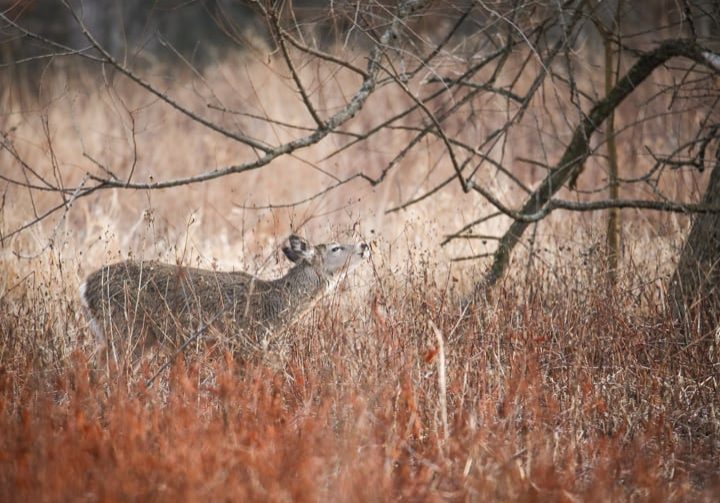Lessons from Winter Wildlife Photography

Coming into winter, I was afraid I wouldn’t see my camera for a while. With temperatures dropping into the teens and twenties, would I need it? Would I find wildlife? My normal places were growing quieter and quieter. The green herons no longer fished from fallen trees in the marsh; the sounds of songbirds floated through the air less and less. The muskrat couple hurried to fill their dens until there was only an occasional sighting on the ice. Canadian geese lined the waters by the hundreds, but how many times can one photograph them? What would winter photography be like for me this year?
Of course, I found that Nature doesn’t disappoint. She always has something to offer. Each season brings change, cycling in a different kind of beauty by the month – sometimes even by the day. As I went into the woods week after week, she stretched out her hand and said, “Come, child, there is so much to see.” Details emerged that I seldom noticed:
Evergreens tall in a grove
A red-shouldered hawk, wingtips outstretched in the crisp air
Dark-eyed Juncos on a timber pile
Snowflake crystals delicate on Goldenrod’s faded summer blooms
Red-bellied woodpeckers on naked gray trunks
Fox squirrels, full in their fall-orange coats, on snowy branches
Deer tracks in crunchy day-old snow
Ice-covered treetops against a brilliant blue sky
Taking all this in now, I can’t help but laugh at my doubts. Nature not only gave me things to photograph, she gave me a feast to enjoy.
I’ve written about this a little bit before, but one of my favorite winter surprises was finding white-tailed deer. In the summer and fall, I saw glimpses of them in the distance, out in fields or across the marsh. But one December morning my husband and I walked down one of our usual trails, and there stood four – two on each side of us. The mothers watched as their young nibbled one or two last bites of fall’s leftovers, and with an invisible signal, they moved on. Unfortunately, they were in a lot of brush, so I only got one clear photo that I liked, but the experience left my heart full – and hopeful.
Slowly, over the next weeks, I learned their patterns. I watched for tracks and recorded in my mind the spots where I saw them each time. I counted the deer every encounter and looked back at some of my photos from the last two years. I figured out there were seven in total – several does and probably three under a year old. Dan and I kept finding one doe and her young one in particular. They granted us permission each visit to get twenty-five yards away (always a respectful distance) and to just be with them. Wow, how those quiet moments watching them fueled me! I was able to make images with my zoom lens over the next days of sweet faces licking snow crystals off trees, noses covered in snowflakes, little ones resting by a log, and mamas munching on pine branches. I also realized I was documenting how much the young ones were growing. There was some definite chub coming on!
If you know me at all, you know I love the mountains. Give me a morning where I can wake up at 4:45 and go find moose, and I’m happy. When I’m home in Indiana, especially in a time of no travel, I get a little angsty after only shooting birds and muskrats. So my wildlife-loving heart got pretty full seeing those seven faces this winter. They showed me there is so much to see, so much to learn anywhere I am. Beautiful creatures, large and small, deserve our respect and protection for the way they survive, for the way they direct us to what matters.
Winter has several weeks to go, and I’m looking forward to it. Nature not only surprised me this season; she gave me a gift. She reminded me (again) to be patient, to slow down and investigate the details. There are so many places we will go, so many things to see.